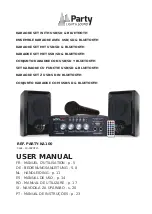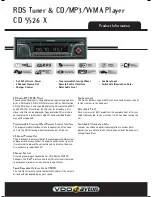
Recording an acoustic guitar with two TM-80 microphones
Place one microphone about 20 cm from the sound hole of
the guitar. This is referred to as the 'on-mic' position. Make sure the microphone diaphragm is
parallel to the guitar. If the sound is too boomy, shift the microphone away from the sound hole
and closer to the bridge.
Place the second microphone about 5 feet in front of the guitar, and at a height of 5 feet off the
floor. This is referred to a the 'off-mic' position. Make sure the diaphragm is facing the guitar.
Another option is to have someone play the guitar while you place the mic where the guitar sounds
the best in the room.
C onnect the microphones to the balanced inputs on the US-4x4, then turn-on the
+48V
switch to
supply phantom power. The TM-80 microphones require phantom power for operation.
C reate two tracks in your DAW software in order to record each mic on its own track. Adjust the
recording levels by using the
GAIN
controls of the US-4x4. Gradually increase the level without
lighting the
PEAK
LED. Setting the DAW software to record standby allows you to check the level
from the computer.
While in standby mode, listen to the sound of each microphone. You may need to make fine
adjustments to the positions of the microphones. The closer the mic is to the sound source, the
larger and more dynamic the low-pitched tones become. This phenomenon is called proximity
effect. On the contrary, the farther away the microphone is, the smaller and milder the sound
becomes.
After the mics are placed, start recording. Whether you choose to monitor the performance
through headphones or not, the balance of the on-mic and off-mic can be changed later.
Another option is to use two mics as a 'stereo pair' in both the on-mic and off-mic positions. Using
four mics in this manner provides a rich, fuller stereo sound. The capsules are placed as close
together as possible – one mic is panned left, and the other panned right.
Recording a v ocal performance while play ing an acoustic guitar
In some cases, vocals and instruments are recorded
separately. Here we will explain an example of how to use two mics to capture the live feel of a
vocal and guitar performance.
For the guitar, place the mic in the 'on-mic' position as described previously. For the vocal, place
the second mic about 20 cm from the mouth (a commercially available pop-guard is recommended
to reduce p-popping).
Note that the vocal microphone can pick up the sound of the guitar as well as the vocal. To reduce
the sensitivity to the guitar, adjust the angle of the microphone as pictured. The TM-80 microphone
has a directional pickup pattern (cardioid), and turning the front of the mic away from the guitar
will lessen the sensitivity to and volume of the guitar.






















